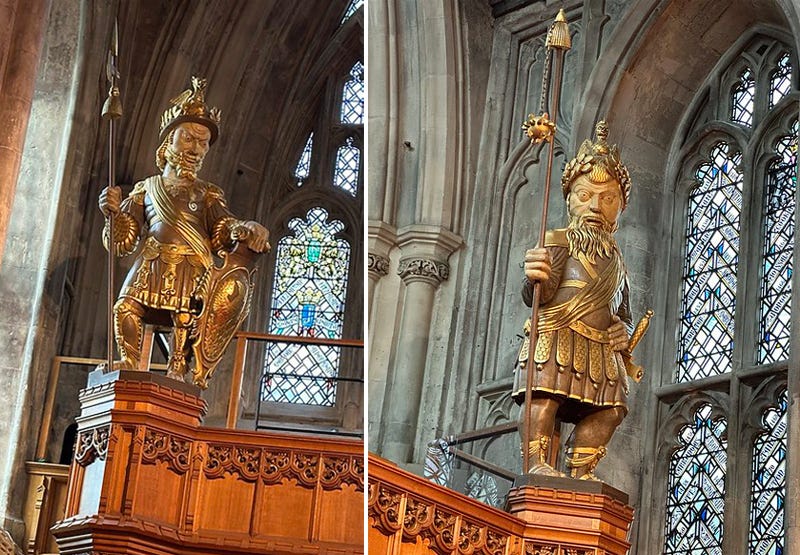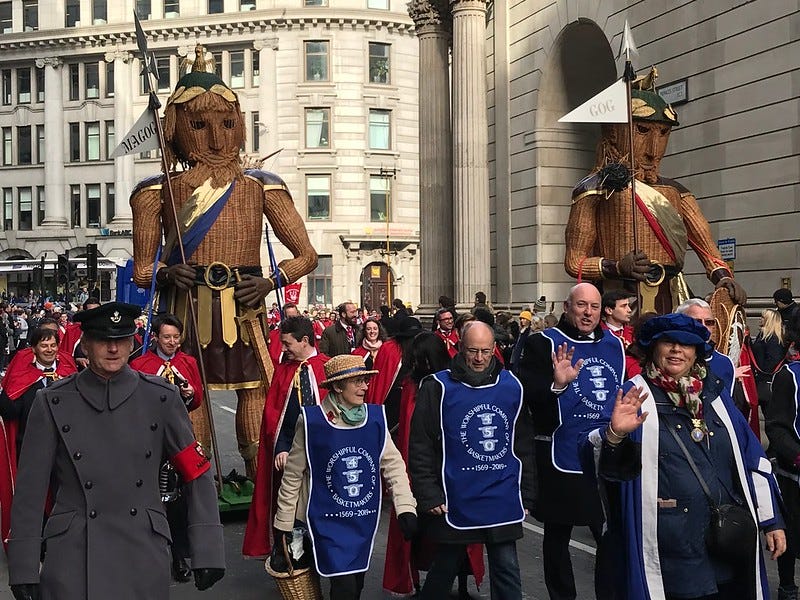Welcome to Londonist: Time Machine’s Friday newsletter for paying subscribers (with a generous teaser for everyone else).
Today, we’re off giant hunting. Anyone who’s attended a Lord Mayor’s Show or entered the medieval Guildhall must have encountered the twin giants known as Gog and Magog. They are ancient symbols of London. But who were they?
That’s for the main section. First, the History Radar.
History Radar
Upcoming events of interest to London history fans.
👨🏾🏫 IGNATIUS SANCHO: On 8 October, Guildhall Library offers a free online talk about the life of Ignatius Sancho. He arrived in England as an orphaned baby, and rose from slave to composer, author and banker after a neighbour recognised his intelligence and began his education.
🍹 SEX, GIN & OPIUM: Three words you might not immediately associate with Charles Dickens, but that's the name of a new evening tour at Charles Dickens Museum. The event (on 9 October, but repeated on future dates; see website) explores the seedier side of Victorian London, and the author's own personal life.
🙆🏾♂️ BLACK REGENCY BRITS: On 10 October, the Bow Street Police Museum in Covent Garden hosts Mary L Shannon, who talks about her book, Billy Walters Is Dancing. It tells the story of Walters, a busker, sailor, immigrant and forgotten Black celebrity from Regency London. 6.30pm
🏥 BLACK NURSES: On 12 October, author Kandace Chimbiri is at the Florence Nightingale Museum in Lambeth to discuss her new book, The Story of Britain's Black Nurses. It's a children’s book, although people of all ages will enjoy and learn from the talk. It's followed by a Q&A.
London Giants: Who Were Gog and Magog?
You can’t miss them. Gog and Magog are the tallest participants in the Lord Mayor’s show. If that doesn’t set them apart, then their wicker-based physiognomies surely do. And they always come as a double act, the Holmes and Watson of the colossi.
Who are they, exactly? Why are they such keen supporters of the Lord Mayor? And were they based on real historical figures? Let’s find out.
Emblems of the City
The marching wicker giants, crafted from willow by the Worshipful Company of Basketmakers, come out on parade every year. They are the most photographed manifestation of Gog and Magog, but they are not the only ones. More rooted versions of the duo can be found inside the Guildhall — the ancient civic heart of the Square Mile. These are they, in all their auric glory:

I’d like to report that these gilded Goliaths have guarded the Guildhall since time immemorial. But, in fact, they were crafted by the sculptor David Evans in 1953. A predecessor Gog and Magog went up in flames during the Blitz. Their fate is alluded to in this remarkable stained glass window elsewhere in Guildhall.
The pair lost during the war were carved from pine by a Captain Richard Saunders of King Street, Cheapside in 1709. They were much celebrated, and a more recognised symbol of the Square Mile than their modern counterparts. But even these early-Georgian manifestations were not the first of their kind.
Representations of Gog and Magog were noted at the Coronation preparations of Elizabeth I in 1558. Four years earlier, they’d greeted Queen Mary and Philip of Spain upon their post-nuptial arrival at London Bridge. Another pair stood on a triumphal arch, which greeted the restored Charles II to Cheapside in 1660. Meanwhile, the official website for the Lord Mayor’s Show claims that the giants have been part of the Lord Mayor’s procession since the reign of Henry V (1413-1422), though as far as I can tell, that’s based on tradition and citation is very much needed.
Whenever they first appeared on the streets of London, Gog and Magog have clearly cast a long shadow. Of course they have. They’re giants. But how did these two scrunch-faced Goliaths come to hobnob with Lord Mayors and monarchs? What’s their origin story?
Gog and Magog: the early years
Our two giants, in name at least, are older than Methuselah’s mother. Literally. Their names feature in the earliest holy books, including some from the Old Testament. Theirs is a long, convoluted story, which I’m going to simplify with the aid of a chronological bullet list:






